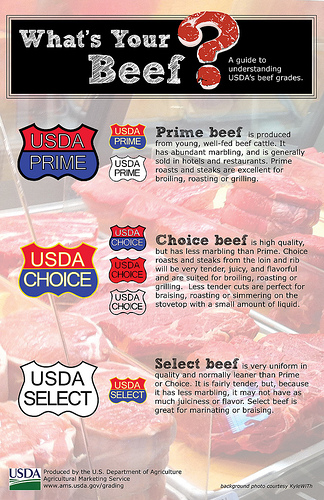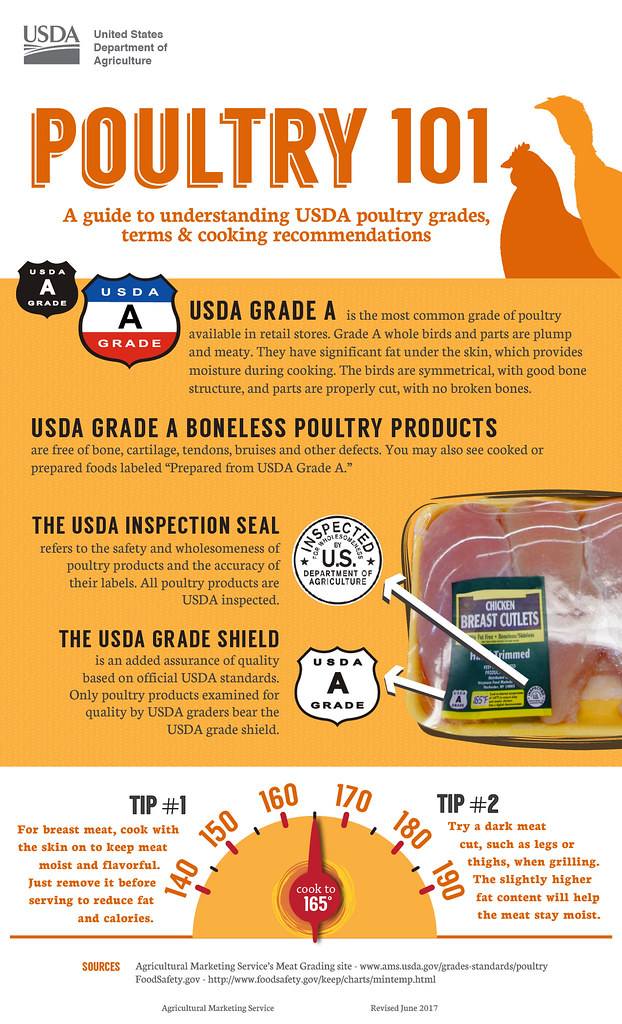2.1.1.5: Inspection and Grading of Meat Products
- Page ID
- 64432
\( \newcommand{\vecs}[1]{\overset { \scriptstyle \rightharpoonup} {\mathbf{#1}} } \)
\( \newcommand{\vecd}[1]{\overset{-\!-\!\rightharpoonup}{\vphantom{a}\smash {#1}}} \)
\( \newcommand{\id}{\mathrm{id}}\) \( \newcommand{\Span}{\mathrm{span}}\)
( \newcommand{\kernel}{\mathrm{null}\,}\) \( \newcommand{\range}{\mathrm{range}\,}\)
\( \newcommand{\RealPart}{\mathrm{Re}}\) \( \newcommand{\ImaginaryPart}{\mathrm{Im}}\)
\( \newcommand{\Argument}{\mathrm{Arg}}\) \( \newcommand{\norm}[1]{\| #1 \|}\)
\( \newcommand{\inner}[2]{\langle #1, #2 \rangle}\)
\( \newcommand{\Span}{\mathrm{span}}\)
\( \newcommand{\id}{\mathrm{id}}\)
\( \newcommand{\Span}{\mathrm{span}}\)
\( \newcommand{\kernel}{\mathrm{null}\,}\)
\( \newcommand{\range}{\mathrm{range}\,}\)
\( \newcommand{\RealPart}{\mathrm{Re}}\)
\( \newcommand{\ImaginaryPart}{\mathrm{Im}}\)
\( \newcommand{\Argument}{\mathrm{Arg}}\)
\( \newcommand{\norm}[1]{\| #1 \|}\)
\( \newcommand{\inner}[2]{\langle #1, #2 \rangle}\)
\( \newcommand{\Span}{\mathrm{span}}\) \( \newcommand{\AA}{\unicode[.8,0]{x212B}}\)
\( \newcommand{\vectorA}[1]{\vec{#1}} % arrow\)
\( \newcommand{\vectorAt}[1]{\vec{\text{#1}}} % arrow\)
\( \newcommand{\vectorB}[1]{\overset { \scriptstyle \rightharpoonup} {\mathbf{#1}} } \)
\( \newcommand{\vectorC}[1]{\textbf{#1}} \)
\( \newcommand{\vectorD}[1]{\overrightarrow{#1}} \)
\( \newcommand{\vectorDt}[1]{\overrightarrow{\text{#1}}} \)
\( \newcommand{\vectE}[1]{\overset{-\!-\!\rightharpoonup}{\vphantom{a}\smash{\mathbf {#1}}}} \)
\( \newcommand{\vecs}[1]{\overset { \scriptstyle \rightharpoonup} {\mathbf{#1}} } \)
\( \newcommand{\vecd}[1]{\overset{-\!-\!\rightharpoonup}{\vphantom{a}\smash {#1}}} \)
\(\newcommand{\avec}{\mathbf a}\) \(\newcommand{\bvec}{\mathbf b}\) \(\newcommand{\cvec}{\mathbf c}\) \(\newcommand{\dvec}{\mathbf d}\) \(\newcommand{\dtil}{\widetilde{\mathbf d}}\) \(\newcommand{\evec}{\mathbf e}\) \(\newcommand{\fvec}{\mathbf f}\) \(\newcommand{\nvec}{\mathbf n}\) \(\newcommand{\pvec}{\mathbf p}\) \(\newcommand{\qvec}{\mathbf q}\) \(\newcommand{\svec}{\mathbf s}\) \(\newcommand{\tvec}{\mathbf t}\) \(\newcommand{\uvec}{\mathbf u}\) \(\newcommand{\vvec}{\mathbf v}\) \(\newcommand{\wvec}{\mathbf w}\) \(\newcommand{\xvec}{\mathbf x}\) \(\newcommand{\yvec}{\mathbf y}\) \(\newcommand{\zvec}{\mathbf z}\) \(\newcommand{\rvec}{\mathbf r}\) \(\newcommand{\mvec}{\mathbf m}\) \(\newcommand{\zerovec}{\mathbf 0}\) \(\newcommand{\onevec}{\mathbf 1}\) \(\newcommand{\real}{\mathbb R}\) \(\newcommand{\twovec}[2]{\left[\begin{array}{r}#1 \\ #2 \end{array}\right]}\) \(\newcommand{\ctwovec}[2]{\left[\begin{array}{c}#1 \\ #2 \end{array}\right]}\) \(\newcommand{\threevec}[3]{\left[\begin{array}{r}#1 \\ #2 \\ #3 \end{array}\right]}\) \(\newcommand{\cthreevec}[3]{\left[\begin{array}{c}#1 \\ #2 \\ #3 \end{array}\right]}\) \(\newcommand{\fourvec}[4]{\left[\begin{array}{r}#1 \\ #2 \\ #3 \\ #4 \end{array}\right]}\) \(\newcommand{\cfourvec}[4]{\left[\begin{array}{c}#1 \\ #2 \\ #3 \\ #4 \end{array}\right]}\) \(\newcommand{\fivevec}[5]{\left[\begin{array}{r}#1 \\ #2 \\ #3 \\ #4 \\ #5 \\ \end{array}\right]}\) \(\newcommand{\cfivevec}[5]{\left[\begin{array}{c}#1 \\ #2 \\ #3 \\ #4 \\ #5 \\ \end{array}\right]}\) \(\newcommand{\mattwo}[4]{\left[\begin{array}{rr}#1 \amp #2 \\ #3 \amp #4 \\ \end{array}\right]}\) \(\newcommand{\laspan}[1]{\text{Span}\{#1\}}\) \(\newcommand{\bcal}{\cal B}\) \(\newcommand{\ccal}{\cal C}\) \(\newcommand{\scal}{\cal S}\) \(\newcommand{\wcal}{\cal W}\) \(\newcommand{\ecal}{\cal E}\) \(\newcommand{\coords}[2]{\left\{#1\right\}_{#2}}\) \(\newcommand{\gray}[1]{\color{gray}{#1}}\) \(\newcommand{\lgray}[1]{\color{lightgray}{#1}}\) \(\newcommand{\rank}{\operatorname{rank}}\) \(\newcommand{\row}{\text{Row}}\) \(\newcommand{\col}{\text{Col}}\) \(\renewcommand{\row}{\text{Row}}\) \(\newcommand{\nul}{\text{Nul}}\) \(\newcommand{\var}{\text{Var}}\) \(\newcommand{\corr}{\text{corr}}\) \(\newcommand{\len}[1]{\left|#1\right|}\) \(\newcommand{\bbar}{\overline{\bvec}}\) \(\newcommand{\bhat}{\widehat{\bvec}}\) \(\newcommand{\bperp}{\bvec^\perp}\) \(\newcommand{\xhat}{\widehat{\xvec}}\) \(\newcommand{\vhat}{\widehat{\vvec}}\) \(\newcommand{\uhat}{\widehat{\uvec}}\) \(\newcommand{\what}{\widehat{\wvec}}\) \(\newcommand{\Sighat}{\widehat{\Sigma}}\) \(\newcommand{\lt}{<}\) \(\newcommand{\gt}{>}\) \(\newcommand{\amp}{&}\) \(\definecolor{fillinmathshade}{gray}{0.9}\)The inspection and grading of meat and poultry are two separate programs within the U.S.Department of Agriculture (USDA). Inspection for wholesomeness is mandatory and is paid for with public funds. Grading for quality is voluntary, and the service is requested and paid for by meat and poultry producers/processors.
Mandatory Federal Inspection
American consumers can be confident that the Food Safety and Inspection Service (FSIS), the public health agency in the USDA, ensures that meat and poultry products are safe, wholesome, and correctly labeled and packaged.
Under the Federal Meat Inspection Act and the Poultry Products Inspection Act , FSIS inspects all raw meat and poultry sold in interstate and foreign commerce, including imported products. The Agency monitors meat and poultry products after they leave federally inspected plants.
Prior to the creation of the FSIS inspection of animal production and slaughter relied almost exclusively on visual inspection of animals, products, and plant operations. This was referred to as the "poke and sniff" method of inspection which did not take into account microbiological activity that could cause illness. However, refinements in animal production reduced disease and created a more homogeneous animal population. Thus, the concerns of today's inspectors are broader and include unseen hazards such as microbiological and chemical contamination.
As discussed in previous sections on prevention of Foodborne illness, measures in food production such as monitoring time and temperature and creating standards of food production in restaurants are designed to minimize the likelihood of harmful bacteria contaminating raw meat and poultry products. However, some bacteria could be present and might become a problem if meat and poultry are not handled safely. To assist food handlers, the USDA requires that safe handling instructions be put on all packages of raw and not fully cooked meat and poultry.
Grading
After meat and poultry are inspected for wholesomeness, producers and processors may request that they have products graded for quality by a licensed Federal grader. The USDA's Agricultural Marketing Service (http://www.ams.usda.gov) is the agency responsible for grading meat and poultry. Those who request grading must pay for the service. Grading for quality means the evaluation of traits related to tenderness, juiciness, and flavor of meat; and, for poultry, a normal shape that is fully fleshed and meaty and free of defects.
USDA grades are based on nationally uniform Federal standards of quality. No matter where or when a consumer purchases graded meat or poultry, it must have met the same grade criteria. The grade is stamped on the carcass or side of beef and is usually not visible on retail cuts. However, retail packages of beef, as well as poultry, will show the U.S. grade mark if they have been officially graded.
The grade symbol and wording are no longer copyrighted; however, according to the Truth in Labeling Law, it is illegal to mislead or misrepresent the shield or wording.
USDA Grades for Meat and Poultry
Beef
Beef is graded as whole carcasses in two ways:
- quality grades - for tenderness, juiciness, and flavor; and
- yield grades - for the amount of usable lean meat on the carcass. There are eight quality grades for beef. Quality grades are based on the amount of marbling (flecks of fat within the lean), color, and maturity.
Quality Grades:

- Prime grade is produced from young, well-fed beef cattle. It has abundant marbling and is generally sold in restaurants and hotels. Prime roasts and steaks are also excellent for dry-heat cooking due to the age of the animal, and less connective tissue (broiling, roasting, or grilling).
- Choice grade is high quality, but has less marbling than Prime. Choice roasts and steaks from the loin and rib will be very tender, juicy, and flavorful and are, like Prime, suited to dry-heat cooking. Many of the less tender cuts, such as those from the rump, round, and blade chuck, can also be cooked with dry heat if not overcooked. Such cuts will be most tender if "braised" — roasted, or simmered with a small amount of liquid in a tightly covered pan.
- Select grade is very uniform in quality and normally leaner than the higher grades. It is fairly tender, but, because it has less marbling, it may lack some of the juiciness and flavor of the higher grades. Only the tender cuts (loin, rib, sirloin) should be cooked with dry heat. Other cuts should be marinated before cooking or braised to obtain maximum tenderness and flavor.
- Standard and Commercial grades are frequently sold as ungraded or as "store brand" meat.
- Utility, Cutter, and Canner grades are seldom, if ever, sold at retail but are used instead to make ground beef and processed products.

Note: Grades such as Prime, Choice and Select are not acceptable terms for raw cuts of pork or poultry
Yield grades range from "1" to "5" and indicate the amount of usable meat from a carcass. Yield grade 1 is the highest grade and denotes the greatest ratio of lean to fat; yield grade 5 is the lowest yield ratio. Though yield grades are not something consumers normally see, they are most useful when purchasing a side or carcass of beef for the freezer.
Veal/Calf
There are five grades for Veal/Calf: prime, choice, good, standard, and utility.
Prime and choice grades are juicier and more flavorful than the lower grades. Because of the young age of the animals, the meat will be a light grayish-pink to light pink, fairly firm, and velvety. The bones are small, soft, and quite red. Cuts such as chops can be cooked by the dry- heat methods of roasting, grilling or broiling.
Lamb
There are five grades for lamb. Normally only two grades are found at the retail level — prime and choice. Lower grades of lamb and mutton (meat from older sheep) — good, utility, and cull — are seldom marked with the grade. Lamb is produced from animals less than a year old. Since the quality of lamb varies according to the age of the animal, it is advisable to buy lamb that has been USDA graded.
- Prime grade is very high in tenderness, juiciness, and flavor. Its marbling enhances both flavor and juiciness.
- Choice grade has slightly less marbling than prime, but still is of very high quality. Most cuts of prime and choice grade lamb (chops, roasts, shoulder cuts, and leg) are tender and can be cooked by the dry-heat methods (broiling, roasting, or grilling). The less tender cuts — breast, riblets, neck, and shank — can be braised to make them tenderer.
Pork
Pork is not graded by USDA quality grades as it is generally produced from young animals that have been bred and fed to produce more uniformly tender meat. Appearance is an important guide in buying fresh pork. Look for cuts with a relatively small amount of fat over the outside and with meat that is firm and grayish pink in color. For best flavor and tenderness, meat should have a small amount of marbling.
Poultry
The USDA grades for poultry are A, B, and C.

- Grade A is the highest quality and the only grade that is likely to be seen at the retail level. This grade indicates that the poultry products are virtually free from defects such as bruises, discolorations, and feathers. Bone-in products have no broken bones. For whole birds and parts with the skin on, there are no tears in the skin or exposed flesh that could dry out during cooking, and a good covering of fat under the skin. Also, whole birds and parts will be fully fleshed and meaty. The U.S. grade shield for poultry may be found on the following chilled or frozen ready- to-cook poultry products: whole carcasses and parts, as well as roasts, tenderloins, and other boneless and/or skinless poultry products that are being marketed. There are no grade standards for necks, wing tips, tails, giblets, or ground poultry.
- Grades B and C poultry are usually used in further-processed products where the
poultry meat is cut up, chopped, or ground. If sold at retail, they are usually not grade
identified.

For more information about meat and poultry grading, go to USDA's Agricultural Marketing Service (AMS) Web site at www.ams.usda.gov/
United States Department of Agriculture
Summary of Federal Inspection Requirements for Meat Products
Source: https://www.fsis.usda.gov/wps/wcm/co...df?MOD=AJPERES
https://www.canr.msu.edu/resources/o...spection_e3114
https://www.nicksolares.com/post/usd...ding-explained


